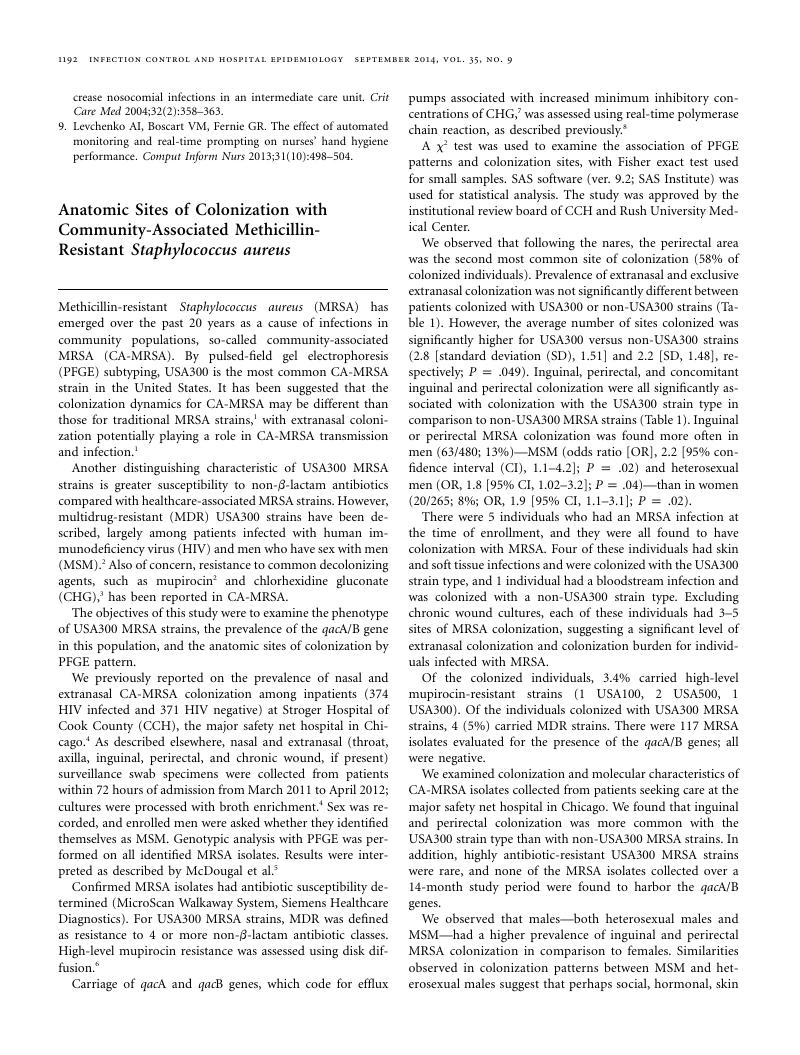Crossref Citations
This article has been cited by the following publications. This list is generated based on data provided by Crossref.
Septimus, Edward J.
and
Schweizer, Marin L.
2016.
Decolonization in Prevention of Health Care-Associated Infections.
Clinical Microbiology Reviews,
Vol. 29,
Issue. 2,
p.
201.
Popovich, Kyle J.
Snitkin, Evan
Green, Stefan J.
Aroutcheva, Alla
Hayden, Mary K.
Hota, Bala
and
Weinstein, Robert A.
2016.
Genomic Epidemiology of USA300 Methicillin-ResistantStaphylococcus aureusin an Urban Community.
Clinical Infectious Diseases,
Vol. 62,
Issue. 1,
p.
37.
Cho, Sun Young
and
Chung, Doo Ryeon
2017.
Infection Prevention Strategy in Hospitals in the Era of Community-Associated Methicillin-Resistant Staphylococcus aureus in the Asia-Pacific Region: A Review.
Clinical Infectious Diseases,
Vol. 64,
Issue. suppl_2,
p.
S82.
Gagnaire, Julie
Verhoeven, Paul O.
Grattard, Florence
Rigaill, Josselin
Lucht, Frédéric
Pozzetto, Bruno
Berthelot, Philippe
and
Botelho-Nevers, Elisabeth
2017.
Epidemiology and clinical relevance ofStaphylococcus aureusintestinal carriage: a systematic review and meta-analysis.
Expert Review of Anti-infective Therapy,
Vol. 15,
Issue. 8,
p.
767.
Park, So Yeon
Chung, Doo Ryeon
Kang, Yu Ri
Kim, So Hyun
Cho, Sun Young
Ha, Young Eun
Kang, Cheol-In
Peck, Kyong Ran
and
Song, Jae-Hoon
2017.
Comparison of subsequent infection in methicillin-resistant Staphylococcus aureus nasal carriers between ST72 community-genotype and hospital genotypes: a retrospective cohort study.
Antimicrobial Resistance & Infection Control,
Vol. 6,
Issue. 1,
LaBreck, Patrick T.
Rice, Gregory K.
Paskey, Adrian C.
Elassal, Emad M.
Cer, Regina Z.
Law, Natasha N.
Schlett, Carey D.
Bennett, Jason W.
Millar, Eugene V.
Ellis, Michael W.
Hamilton, Theron
Bishop-Lilly, Kimberly A.
and
Merrell, D. Scott
2018.
Conjugative Transfer of a Novel Staphylococcal Plasmid Encoding the Biocide Resistance Gene, qacA.
Frontiers in Microbiology,
Vol. 9,
Issue. ,
Htun, H. L.
Kyaw, W. M.
de Sessions, P. F.
Low, L.
Hibberd, M. L.
Chow, A.
and
Leo, Y. S.
2018.
Methicillin-resistantStaphylococcus aureuscolonisation: epidemiological and molecular characteristics in an acute-care tertiary hospital in Singapore.
Epidemiology and Infection,
Vol. 146,
Issue. 14,
p.
1785.
Turner, Nicholas A.
Sharma-Kuinkel, Batu K.
Maskarinec, Stacey A.
Eichenberger, Emily M.
Shah, Pratik P.
Carugati, Manuela
Holland, Thomas L.
and
Fowler, Vance G.
2019.
Methicillin-resistant Staphylococcus aureus: an overview of basic and clinical research.
Nature Reviews Microbiology,
Vol. 17,
Issue. 4,
p.
203.
Popovich, Kyle J
2020.
Intersection of Hiv and community-associated methicillin-resistant
Staphylococcus aureus
.
Future Virology,
Vol. 15,
Issue. 1,
p.
53.
Barcudi, Danilo
Sosa, Ezequiel J.
Lamberghini, Ricardo
Garnero, Analía
Tosoroni, Dario
Decca, Laura
Gonzalez, Liliana
Kuyuk, María A.
Lopez, Teresa
Herrero, Ivana
Cortes, Paulo
Figueroa, Myrian
Egea, Ana L.
Gagetti, Paula
Fernandez Do Porto, Darío A.
Corso, Alejandra
Turjanski, Adrián G.
Bocco, José L.
and
Sola, Claudia
2020.
MRSA dynamic circulation between the community and the hospital setting: New insights from a cohort study.
Journal of Infection,
Vol. 80,
Issue. 1,
p.
24.
Long, Dustin R.
Bryson-Cahn, Chloe
Pergamit, Ronald
Tavolaro, Celeste
Saigal, Rajiv
Chan, Jeannie D.
and
Lynch, John B.
2021.
2021 Young Investigator Award Winner: Anatomic Gradients in the Microbiology of Spinal Fusion Surgical Site Infection and Resistance to Surgical Antimicrobial Prophylaxis.
Spine,
Vol. 46,
Issue. 3,
p.
143.
Fatima, Tazeen
Fatima, Mehreen
and
Fatima, Tehseen
2022.
MRSA Infection Prevention and Control – Where Do We Stand?.
Journal of Preventive, Diagnostic and Treatment Strategies in Medicine,
Vol. 1,
Issue. 4,
p.
199.
Popovich, Kyle J
and
Weinstein, Robert A
2023.
Questioning Old Staphylococcus aureus Beliefs With New Technology.
The Journal of Infectious Diseases,
Vol. 227,
Issue. 9,
p.
1028.
Russakoff, Benjamin
Wood, Colin
Lininger, Monica R
Barger, Steven D
Trotter, Robert T
Maltinsky, Sara
Mbegbu, Mimi
Coyne, Briana
Panisello Yagüe, David
Kyman, Shari
Tucker-Morgan, Kara
Ceniceros, Kathya
Padilla, Cristina
Hurtado, Kevin
Menard, Ashley
Villa, Francisco
Wayment, Heidi A
Hepp, Crystal
Furstenau, Tara
Fofanov, Viacheslav
Liu, Cindy M
and
Pearson, Talima R
2023.
A Quantitative Assessment of Staphylococcus aureus Community Carriage in Yuma, Arizona.
The Journal of Infectious Diseases,
Vol. 227,
Issue. 9,
p.
1031.
Barger, Steven D.
Lininger, Monica R.
Trotter, Robert T.
Mbegbu, Mimi
Kyman, Shari
Tucker-Morgan, Kara
Wood, Colin
Coyne, Briana
Russakoff, Benjamin
Ceniceros, Kathya
Padilla, Cristina
Maltinsky, Sara
Pearson, Talima
and
Khan, Samiullah
2023.
Cross-sectional study of the association of social relationship resources with Staphylococcus aureus colonization in naturally occurring social groups along the US/Mexico border.
PLOS ONE,
Vol. 18,
Issue. 4,
p.
e0284400.



